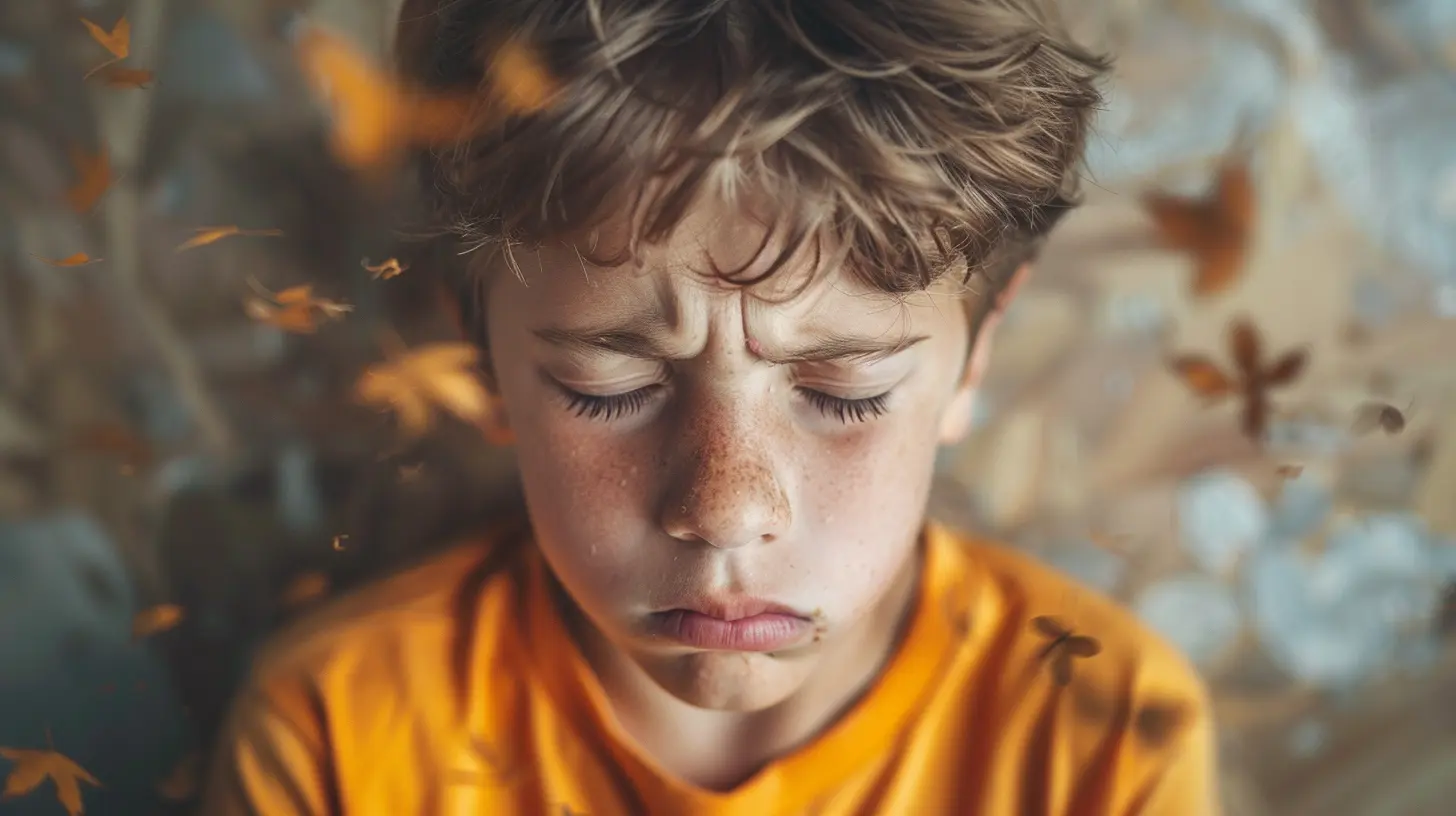Positive Ways to Handle Your Child’s Anxiety
17 August 2025
Parenting is like being the captain of a ship sailing through unpredictable waters. Some days, the sea is calm, and your child is all smiles. Other days, storm clouds roll in, and anxiety takes over like an unexpected tidal wave. It’s tough to see your little one struggle with worry, fear, or nervousness. But don’t stress—there are plenty of positive ways to help them navigate these emotions.
In this guide, we’ll explore how to handle your child’s anxiety with patience, love, and a dash of creativity. 
🌟 Understanding Anxiety in Children
Before diving into solutions, let’s first understand what childhood anxiety looks like.
What Does Anxiety Look Like in Kids?
Anxiety isn’t always obvious. Sometimes, it wears a disguise—like tummy aches, tantrums, or sudden clinginess. Here are some common signs:- Frequent stomach aches or headaches (with no medical cause).
- Trouble sleeping or frequent nightmares.
- Avoiding social situations or new activities.
- Excessive worrying about school, friends, or family.
- Difficulty concentrating or zoning out.
- Unexplained mood swings or irritability.
If your child is showing these signs, it doesn’t mean there’s something wrong with them. It simply means they need some extra support to manage their emotions.
Why Do Kids Feel Anxious?
Anxiety in kids can stem from various sources:- School Stress – Homework overload, tests, or peer pressure can feel overwhelming.
- Big Life Changes – Moving to a new home, starting school, or changes in family dynamics can trigger anxiety.
- Genetics – If you’re an anxious person, chances are your child might have inherited some of that tendency.
- Overstimulation – Today’s fast-paced world (hello, screens!) can overload young minds.
Now that we know the why, let’s talk about the how—as in, how to help! 
🌈 Positive Ways to Handle Your Child’s Anxiety
1. Stay Calm and Be Their Safe Space
Ever noticed how kids tend to mirror our emotions? If you freak out when they’re anxious, it only reinforces their fear. Instead, be the calm in their storm.- Use a gentle voice.
- Offer comforting touch (a hug works wonders!).
- Reassure them by saying, "It's okay to feel this way. I'm here for you."
Children need to know they’re safe and loved, no matter what emotions they’re experiencing.
2. Encourage Open Conversations
Kids won’t always outright say, "Hey, Mom/Dad, I’m feeling anxious today." Instead, their emotions might come out through meltdowns, defiance, or silence.Create a safe space where they feel comfortable opening up:
- Ask open-ended questions like, "What’s something that made you feel nervous today?"
- Validate their feelings by saying, "I understand that must have been tough for you."
- Avoid dismissing their worries with "Oh, don’t be silly!"—what seems small to you might feel huge to them.
By making an effort to listen, you’re letting them know their feelings matter.
3. Teach Deep Breathing Techniques
Breathing exercises work like magic when anxiety strikes! Teach your child some simple deep-breathing techniques:- Balloon Breaths – Tell them to imagine inflating a big balloon by taking a deep breath in… and then slowly releasing the air as they exhale.
- 5-Second Breathing – Inhale for 5 seconds, hold for 5, and exhale for 5.
- Blowing Bubbles – Have them blow actual bubbles; it forces slow, controlled breathing!
These exercises can quickly help calm their racing heart and scattered thoughts.
4. Create a “Worry Box”
Kids have a lot on their minds, but writing things down can help! Grab a simple shoebox and turn it into a “Worry Box.”Here’s how it works:
- Have them write (or draw) what’s bothering them on small pieces of paper.
- Let them drop their worries into the box.
- Once it’s in the box, tell them they can let go of that worry for now.
This physical act of "putting worries away" can relieve stress and make fears feel more manageable.
5. Use Positive Affirmations
Words are powerful. Teach your child to replace anxious thoughts with uplifting ones:- "I am safe."
- "I can face my fears."
- "I am strong and capable."
- "This feeling will pass."
Repeating these affirmations can gradually rewire their brain to focus on the positive rather than the fearful.
6. Stick to a Routine
Kids thrive on predictability. When life feels chaotic, their anxiety flares up. Creating a consistent daily routine provides a sense of security.- Set specific times for meals, homework, and bedtime.
- Make sure they get enough sleep—tired kids are more prone to anxiety!
- Include quiet time for relaxation or reading.
A well-structured day can help them feel more in control.
7. Get Moving! Exercise is a Natural Stress Reliever
Physical activity is a fantastic way to channel anxious energy. Encourage your little one to:- Jump on a trampoline.
- Go for a nature walk.
- Dance around the living room.
- Do some kid-friendly yoga.
Exercise releases endorphins (aka the "happy hormones")—and who doesn’t want more of those?
8. Limit Screen Time (Especially Before Bed)
Too much screen time, especially social media or action-packed videos, can overstimulate kids and make their anxiety worse.- Set boundaries around screen time.
- Encourage screen-free activities like puzzles, crafts, or reading.
- Create a relaxing bedtime routine that doesn’t involve tablets or TV.
A calmer mind before bed = better sleep = less stress!
9. Practice Exposure, Not Avoidance
It’s natural to want to protect your child from anxiety-inducing situations, but avoiding fears only strengthens them.- If they’re scared of speaking in class, encourage them to raise their hand just once.
- If they fear the dark, use a nightlight instead of keeping every light on.
- If they get nervous at social events, start with small gatherings and gradually build up.
Small, manageable challenges build confidence over time!
10. Seek Professional Help When Needed
Sometimes, anxiety is more than just a phase. If it’s interfering with your child’s daily life, don’t hesitate to seek guidance from a therapist or counselor. There’s zero shame in getting professional support—it’s just like visiting a doctor for a physical ailment.
💖 Final Thoughts
Handling your child’s anxiety isn’t about making their worries disappear—it’s about equipping them with the tools to manage those fears in a healthy way.Remember:
- Be patient.
- Be their safe space.
- Give them coping strategies.
- Lead by example (kids absorb everything).
Parenting a child with anxiety is like being their emotional lifeguard—you can’t stop the waves, but you can teach them how to swim. With love, understanding, and a few deep breaths, they’ll learn to navigate life’s worries with confidence.
all images in this post were generated using AI tools
Category:
Positive ParentingAuthor:

Zelda Gill
Discussion
rate this article
1 comments
Callisto Wilson
Empower their journey with love!
August 25, 2025 at 3:02 AM

Zelda Gill
Thank you! Love is indeed a powerful tool in supporting our children's emotional well-being.


